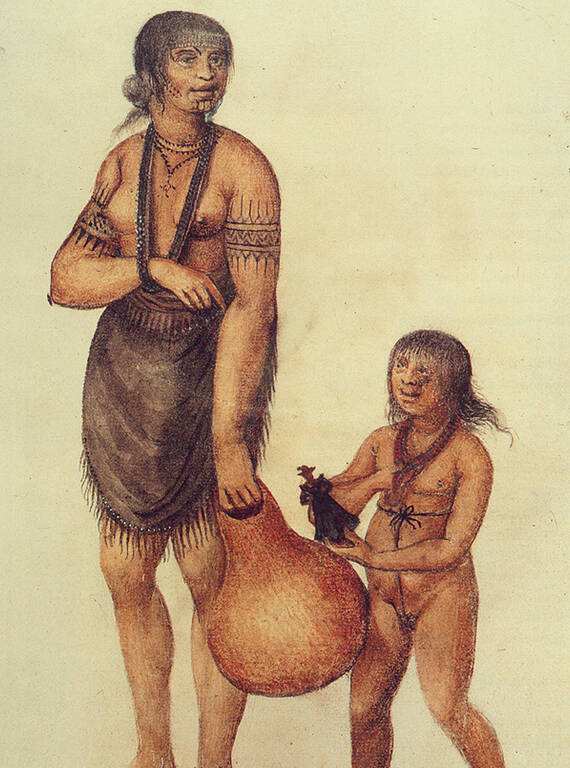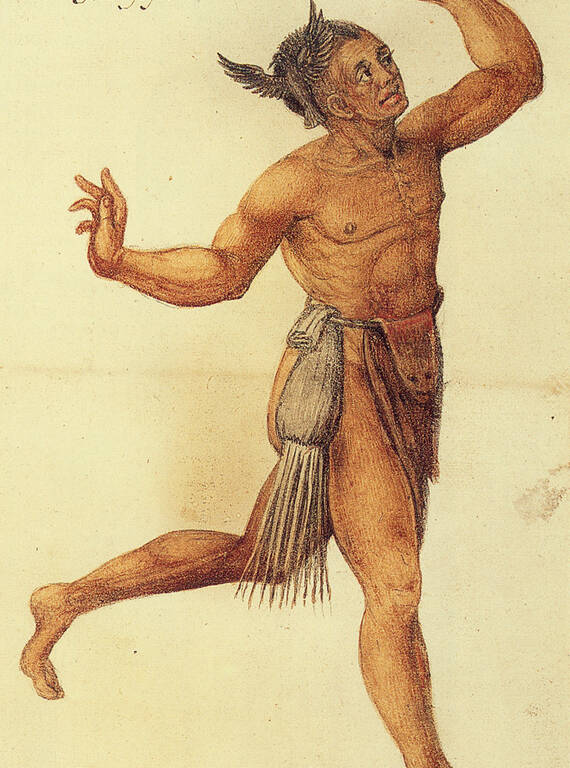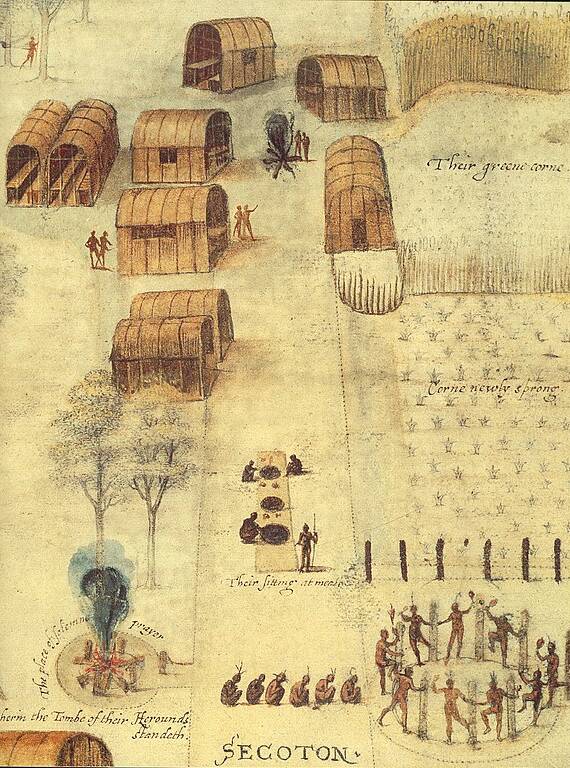Centuries before Instagram, John White’s drawings were the ‘social media’ that allowed explorers to share new discoveries with people around the globe.
As English explorers ventured into North America in the 1580s, the best documentation of what they found came through the eyes of two men, John White and Thomas Harriot. Their work hugely influenced Europeans’ understanding and perceptions of the people, plants and creatures that inhabited the planet, likely in the same awe-inspiring way National Geographic photos often impress and astound people today.
White’s sketches of Native Americans were of particular interest. Indigenous communities thrived along coastal North Carolina for millennia before English expeditions arrived, according to the National Park Service. The Algonquin, in particular, had inhabited the region for more than 800 years.

Watercolor painting by John White in 1585.
Via Wikimedia CommonsVisitors to the Outer Banks today are reminded of these earlier inhabitants through place names. The towns of Manteo and Wanchese honor the Native men who became translators between their tribes and the English, while Roanoke and Chicamacomico had been Native villages.
An ethnographer and illustrator, White already had documented Inuit culture on Canada’s Baffin Island in the 1570s when statesman and explorer Sir Walter Raleigh selected him to join England’s first attempts to establish a foothold in the “New World.”

Watercolor by John White, 1585.
Via Wikimedia CommonsFor the 1580s voyages, Raleigh tasked White and Harriot with studying the unknown continent and the riches they hoped it would contain. Early interactions between the English and Algonquin were cordial, and White was able to sketch the Native people as well as the area’s flora and fauna, while scientist and mathematician Thomas Harriot kept a written account of what they saw. They also mapped the region.
Once back home, Harriot published “A Briefe and True Report of The New Found Land of Virginia” in 1590, featuring 28 engravings by Theodor de Bry based on White’s illustrations, which included animal and plant species not found in Europe, as well as paintings of the Algonquins. The volume was published in four languages — Latin, German, English and French.
The Park Service includes reproductions of some of the men’s work in its visitor center at Fort Raleigh National Historic Site. White’s original sketches are preserved at The British Museum.
With expert detail, White captured the Algonquin’s culture and way of life, including how they dressed, raised food, organized their villages and held ceremonies. Harriot noted that about 200 people lived in each Algonquin village, led by a chief who inherited power through the mother’s family.

Watercolor of an Algonquin village by John White, 1585.
Via Wikimedia CommonsThe Algonquin culture was strongly influenced by the seasons. Men hunted and fished, while women raised crops and gathered edibles from the forests and grasslands. Harriot noted that the Native Americans ate less and lived longer than the English.
With the same skill he used in portraying people, White meticulously illustrated plants and wildlife. His maps of the Outer Banks informed European cartography for the next 100 years.
In the introduction of a 1972 reprinting of Harriot’s book, The British Museum’s Paul Hulton wrote that White clearly possessed “a quick eye and hand” to record such detail in each drawing.
The “Report,” as it became known, was the first scientific text and illustration of its kind. “That is not to say that is it entirely objective or free from wishful thinking, but the approach and method are factual and analytical,” Hulton wrote. Many of de Bry’s engravings from White’s sketches made the Native Americans’ faces appear more European than White’s originals, he added.
Subsequent reports from North America would not compare to Harriot and White’s keen observations, so their work came to typify other Native cultures in North America throughout the 18th century, Hulton wrote.
Little is known about White after a failed colony on Roanoke Island, for which he had been appointed governor, disappeared.

The Lost Colony — An Outer Banks Mystery
On the North Carolina coast, a 400-year-old unanswered question still piques people’s curiosity. What happened to the group of colonists who vanished while trying to start England’s first settlement in…
See more ›He left the group to return to England for supplies a short time after the settlement started in 1587. When he returned three years later, the colonists — including his daughter, son-in-law and grandchild Virginia Dare, the first English child born in North America — had vanished. Historians believe White died in Ireland in the early 1600s. His documentation partner, Harriot, continued his studies and publications in England and died in 1621.
Descendants of the Carolina Algonquins are still among us, according to anthropologists. The 2021 book “Manteo’s World” by Helen C. Rountree explains that Algonquin culture on the coast gradually changed to incorporate more English tools, clothing, livestock and building methods after the 1580s.
Rather than be conquered in war, the Algonquin primarily were “flooded out” by the overwhelming increase of Europeans by the mid-17th century. Some left the region to join Native communities further inland or died from disease, while others gradually adapted to the dominant English culture and mixed with its members during the 18th and 19th centuries, losing their language and traditions along the way.
Stay On Top of News
Our email newsletter shares the latest on parks.
“The Indians in the Sounds region did not vanish; they only became harder to distinguish from other ethnic groups in the region,” Rountree wrote.
Given that most of what we know about the Algonquins is based on White’s paintings, the eventual thinning of Algonquin culture makes White and Harriot’s documentation just as important and fascinating today as it was 400 years ago.
About the author
-
 Linda Coutant Staff Writer
Linda Coutant Staff WriterAs staff writer on the Communications team, Linda Coutant manages the Park Advocate blog and coordinates the monthly Park Notes e-newsletter distributed to NPCA’s members and supporters. She lives in Western North Carolina.
-
General
-
- NPCA Region:
- Southeast